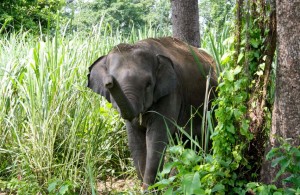Deep in the jungle gloom a striped predator lurks. Programed by instincts genetically implanted millions of years ago, the cat waits patiently for a herd of spotted deer to make their way through tall grass towards a nearby water hole. Barely one in 10 attempts to kill will be successful, but because of sheer persistence, such odds work in favor of the hunter. Contrary to popular belief, success depends less on speed and power, more on stealth and ambush. In all probability a young, weak or careless deer will fall prey to the tiger. The fascinating drama between predator and prey has gone on uninterrupted for years and has been responsible for the perfection in nature which so moves and inspires us.
a nearby water hole. Barely one in 10 attempts to kill will be successful, but because of sheer persistence, such odds work in favor of the hunter. Contrary to popular belief, success depends less on speed and power, more on stealth and ambush. In all probability a young, weak or careless deer will fall prey to the tiger. The fascinating drama between predator and prey has gone on uninterrupted for years and has been responsible for the perfection in nature which so moves and inspires us.
Rich Diversity: Unique, still mysterious, and forever fascinating, the natural history of the Indian subcontinent remains largely unstudied and its natural wealth little appreciated. Geological events that took place millions of years ago created an incomparable diversity of ecosystems. In the north the legendary snowcapped Himalayan ranges house rare and elusive creatures such as snow leopard, musk deer, ibex and pheasants of all descriptions.
 The Thar, also called the Great Indian Desert, sprawls between India and Pakistan in the northwest and supports a surprising variety of hardy plants and animals, several found nowhere else on earth. Towards the east, bordering Bhutan, Bangladesh and Burma, cloud forests and swamps shelter life forms ranging from tigers, elephants, rhinos and gibbons to the largest moth and some of the rarest orchids in the world. The lower slopes and foothills of the Himalaya, clothed in verdant coniferous forests and grasslands, are the last refuge of several endangered plant and animals pecies.The great floodplains of the Indus, Ganga and Brahmaputra rivers, though radically altered by man’s agricultural life-style, are still among the most fertile areas in the world. The Western Ghats, an ancient chain of hills running from north to south, fringing the western coast of India, are perhaps the last hop
The Thar, also called the Great Indian Desert, sprawls between India and Pakistan in the northwest and supports a surprising variety of hardy plants and animals, several found nowhere else on earth. Towards the east, bordering Bhutan, Bangladesh and Burma, cloud forests and swamps shelter life forms ranging from tigers, elephants, rhinos and gibbons to the largest moth and some of the rarest orchids in the world. The lower slopes and foothills of the Himalaya, clothed in verdant coniferous forests and grasslands, are the last refuge of several endangered plant and animals pecies.The great floodplains of the Indus, Ganga and Brahmaputra rivers, though radically altered by man’s agricultural life-style, are still among the most fertile areas in the world. The Western Ghats, an ancient chain of hills running from north to south, fringing the western coast of India, are perhaps the last hop e for some of Asia’s densest rain forests. In the scrub and grasslands of the Deccan Plateau, naturalists have recently rediscovered Jerdon’s double-branded courser, a ground bird which was presumed extinct for nearly 80 years. Running all along the peninsula’s coastline are some of the world’s finest and most indiscriminately exploited coral Preceding pages, 18th-Century hunting camp.
e for some of Asia’s densest rain forests. In the scrub and grasslands of the Deccan Plateau, naturalists have recently rediscovered Jerdon’s double-branded courser, a ground bird which was presumed extinct for nearly 80 years. Running all along the peninsula’s coastline are some of the world’s finest and most indiscriminately exploited coral Preceding pages, 18th-Century hunting camp.
Left, Mughal Emperor Akbar hunting, from the 16th-formations, sand bars and mangroves. Off the southern tip of India, Sri Lankan forests thrive even as they provide naturalists with several fascinating pointers towards the evolution of life on earth. That leopards managed to colonize Sri Lanka, for instance, while tigers never reached its shores, indicates that the island separated from the Asian mainland before the spread of the tiger from Central Asia to the north Indian plains. Many unanswered questions, however, still lie hidden in the mists of prehistory, wrapped in the many marvels and mysteries of the natural world.
Eden Besieged: For long, Africa has been regarded as the Mecca of wildlife. Justifiably so, but in recent years the natural wealth of the Indian subcontinent has begun to offer naturalists, tourists and researchers a fascinating alternative to the once-dark continent. Tropical Asia, after all, probably houses the richest diversity of life forms on the face of the earth. And the Indian peninsula might well be considered the cornerstone of this Eden — an Eden, unfortunately, under siege from one-fifth of humanity.
In 1271 A.D. a young adventurer departedfrom his native Venice on a voyage of discovery. Among the other incredible stories he related inhis “Book of Marvels,” he spoke of a wondrous land filled with curious animals, like elephants, rhinos and great striped cats. That land was India. The man was Marc o Polo. Incredibly, more than a thousand years before Marco Polo discovered the riches of India, Emperor Ashoka, who then ruled most of this vast region, had realized the value of its natural wealth and passed edicts to protect it. But that was still an age when man had need to “conquer” nature to carve an acceptable niche for himself in a hostile world. Yet, somehow, the awe and respect for natural systems, on which the very existence of the Indian people has always been dependent, prevailed. Animals have always played an important role in the daily lives of Indians. Regional mythology, religion and even social mores are entwined with rituals which involve the deification of plants, animals and the elements.
o Polo. Incredibly, more than a thousand years before Marco Polo discovered the riches of India, Emperor Ashoka, who then ruled most of this vast region, had realized the value of its natural wealth and passed edicts to protect it. But that was still an age when man had need to “conquer” nature to carve an acceptable niche for himself in a hostile world. Yet, somehow, the awe and respect for natural systems, on which the very existence of the Indian people has always been dependent, prevailed. Animals have always played an important role in the daily lives of Indians. Regional mythology, religion and even social mores are entwined with rituals which involve the deification of plants, animals and the elements.
It was only when the British took over the subcontinent, that development first began to take a serious toll. Vast Burmese teak forests were razed to fabricate ships and homes for the Empire. Uncounted natural habitats were destroyed to obtain vital cash crops such as tea and cotton. The land was ripe for the taking and had never really been managed. Quite obviously, neither was it left to its own excellent devices as it had been for millions of years. The exploitation had begun in earnest.
Those who fervently hoped that independence would reverse the trend towards poor land use were mistaken. After 1947 the face of the Indian subcontinent began to undergo its most drastic change. The people were poor, and their leaders filled with a genuine desire to “give” their wards something, anything to fill their empty and resource-starved lives. The only freely available c ommodity was land. No one thought of the disastrous consequences of converting wild grasslands and forests to pastures or industrial dumpyards. India, Pakistan, Bangladesh, Nepal and Sri Lanka are all currently reeling under the stress of shortsighted past decisions. And, in spite of knowing better, today’s managers often continue to opt for minor political gains, using land as a tragic medium of barter to appease an unknowingpeople. The resultant havoc caused by nature’s response to bad land management — floods, droughts and famines — is too well known to merit further comment.
ommodity was land. No one thought of the disastrous consequences of converting wild grasslands and forests to pastures or industrial dumpyards. India, Pakistan, Bangladesh, Nepal and Sri Lanka are all currently reeling under the stress of shortsighted past decisions. And, in spite of knowing better, today’s managers often continue to opt for minor political gains, using land as a tragic medium of barter to appease an unknowingpeople. The resultant havoc caused by nature’s response to bad land management — floods, droughts and famines — is too well known to merit further comment.
The fact that representative pockets of wild habitats survive on the subcontinent today has very little to do with man’s realization of the worth of his natural heritage. Rather, credit is due to the inborn resilience of plants and animals which have evolved near perfect survival techniques after living for millions of years in a hostile environment. To understand how blessed the region once was, one needs merely travel to reserves such as Kanha or Bandhavgarh in Madhya Pradesh, Ranthambhore in Rajasthan, Manas in Assam, Chitwan in Nepal, Wilpattu in Sri Lanka, and the Sunderbans in West Bengal. At one time the entire subcontinent was as rich and produc-tive as these oases of restraint and toler ance. In such havens, the sight of thriving ecosystems provides a glimpse into the way things were, before the evolution of man. The profusion of life is truly staggering as lianas, vines, fungi and animals of every description are seen living out their threatened existences, oblivious of the inexorable press of humanity around them. These isolated green vaults are now zealously protected as a result of our newly awakened understanding of the consequences of environmental imbalances. But for vast areas it is already too late. The malaise has taken a firm grip of the land and many once verdant expanses have forever been reduced to dust.
ance. In such havens, the sight of thriving ecosystems provides a glimpse into the way things were, before the evolution of man. The profusion of life is truly staggering as lianas, vines, fungi and animals of every description are seen living out their threatened existences, oblivious of the inexorable press of humanity around them. These isolated green vaults are now zealously protected as a result of our newly awakened understanding of the consequences of environmental imbalances. But for vast areas it is already too late. The malaise has taken a firm grip of the land and many once verdant expanses have forever been reduced to dust.
What is likely to strike most visitors to the many reserves in the region is the stark contrast between the outside and inside of protectedplaces. Almost without exception, the approach roads are barren and, often, a sense of apprehen- . sion creeps in, as you begin to wonder what lies in store. The moment you enter, say, the Periyar Tiger Reserve, however, the apprehension j vanishes as you are transported to a primeval peace so familiar to anyone whose soul is stirred by the outdoors. 
Stripes and Ivory: But there is a fundamental difference between the wildlife experience of the Indian jungle and that found in Africa. To begin with, tropical jungles are dense and most often visibility is fairly restricted. All too often visitors, lured to India by tourist brochures which prom ise exciting “tiger safaris,” are therefore, disappointed to see fewer animals than they expected.It’s not that the surviving jungles arethinly populated, but that most creatures, which have mastered the art of camouflage and deception over millennia, are virtually impossible to spot unless you know what to look for. With the help of an experienced guide, however, a moving twig becomes a praying mantis, part of a tree stump takes wing to reveal itself as a roosting nightjar, or, with some luck, an imperceptible movement in the grass turns out to be none other than that of the tiger.
ise exciting “tiger safaris,” are therefore, disappointed to see fewer animals than they expected.It’s not that the surviving jungles arethinly populated, but that most creatures, which have mastered the art of camouflage and deception over millennia, are virtually impossible to spot unless you know what to look for. With the help of an experienced guide, however, a moving twig becomes a praying mantis, part of a tree stump takes wing to reveal itself as a roosting nightjar, or, with some luck, an imperceptible movement in the grass turns out to be none other than that of the tiger.
At one time “tigerland” comprised virtually the whole Indian subcontinent. Fearing no animal, the great cats colonized every imaginable habitat, from the lower slopes of high mountains, to dsecertified crub lands, rain forests and swamps. Positioned at the apex of the food chain, tigers managed to carve a secure niche for themselves while still allowing adaptable predators such asthe leopard and several lesser cats to co-exist. With the arrival of Homo sapiens all this changed. Having learned to alter the environment to suit his own convenience, man began to make inroads into virgin jungles, slashing and burning in his frantic haste to convert hostile habitats into Ili hospitable havens. Over a period of time, having established his dominion over the natural world, he began to hunt for pleasure. Persecuted for their skin and for the illusion of bravery surrounding shikar, tigers reacted by altering their life-style. The once proud predators which hunted by day, turned to the security of nocturnal life to avoid humans. And, as people’s numbers began to swell, the tiger retreated deeper into the jungle. A similar fate befell most of the other animals that shared the tiger’s domain.
Elephants, perhaps more than any other animals, typify the man-animal conflict in India. The large beasts require vast ranges in order to survive. Their daily requirement of green foddercan exceed 450 lb (200 kg) per da y. Plantations, hydel projects and jungle clearances have so totally fragmented their habitats that elephants, which once roamed virtually contiguous forests, must now contend with existence in small pockets, and when they do try to migrate to distant pastures they come into conflict with man, most often with disastrous results for both. The problem of habitat degradation is comepounded by man’s ancient yearning for ivory. Even today, despite stringent laws, elephants regularly fall victim to poachers who often use poison and pit traps to bring down their quarry, wiping out entire families.
y. Plantations, hydel projects and jungle clearances have so totally fragmented their habitats that elephants, which once roamed virtually contiguous forests, must now contend with existence in small pockets, and when they do try to migrate to distant pastures they come into conflict with man, most often with disastrous results for both. The problem of habitat degradation is comepounded by man’s ancient yearning for ivory. Even today, despite stringent laws, elephants regularly fall victim to poachers who often use poison and pit traps to bring down their quarry, wiping out entire families.
Conservation: Fortunately, in recent years, the Indian government has taken a more progressive attitude towards the protection of wild animals. There is no doubt that execution still lags far behind intention; however, as a policy, the authorities have come down hard on known traders, poachers and exploiters. Consequently, India is probably the last hope of survival for the one-horned rhino, the great Indian bustard, the gharial (a fish-eating crocodile) and a host of other highly endangered species, many endemic to the subcontinent. Moreover, recognizing thatknowledge is the first step towards protection, sterling organizations such as the Bombay Natural History Society (BNHS) are being partially funded by the government to carry out field natural-history projects to evolve management strategies for wild habitats. Through such pio neering efforts the strands of relationships between life forms and the habitats they live in are slowly being pieced together. Avifauna and hydrobiological studies are helping us to understand the critical needs of birds which migrate to the subcontinent from distant nesting grounds in Siberia, Afghanistan, Tibet and China. The thriving wintering grounds of such birds, like Rajasthan’s famous Keoladeo Ghana National Park (Bharatpur) and Tamil Nadu’s Point Calimere Sanctuary, where the BNHS has permanent research stations, are fine testimonials towell-executed conservation action. In the ethereal atmosphere of these wilderness areas it is easy to forget the ecological problems that beset the subcontinent as a whole.
neering efforts the strands of relationships between life forms and the habitats they live in are slowly being pieced together. Avifauna and hydrobiological studies are helping us to understand the critical needs of birds which migrate to the subcontinent from distant nesting grounds in Siberia, Afghanistan, Tibet and China. The thriving wintering grounds of such birds, like Rajasthan’s famous Keoladeo Ghana National Park (Bharatpur) and Tamil Nadu’s Point Calimere Sanctuary, where the BNHS has permanent research stations, are fine testimonials towell-executed conservation action. In the ethereal atmosphere of these wilderness areas it is easy to forget the ecological problems that beset the subcontinent as a whole.
Wildlife and Tourism: There is no doubt about it. Natural India awaits discovery. Despite the lack of sophisticated tourist infrastructure, the heat and humidity, people are drawn back to the forests which Kipling immortalized. In any event, the secret for visitors lies in knowing what to expect and in understanding that the privilege of stepping into a pure and untouched world is a reward in itself. Actual animal sightings, fortunately on the increase each day as protection lends security to once shy creatures, must be viewed as a lucky bonus.
Recognizing the tourist potential of wildlife the governments of India, Nepal and Sri Lanka have gone out of their way to cater to the basic requirements of nature lovers. From Kashmir and Ladakh, through the Garhwal Himalaya and eastward to Assam, organized treks, river rafting and wildlife viewing facilities are emerging, as private and government agencies gear up to meet the new influx of adventure-seekers from all over the world. The Royal Chitwan National Park in Nepal has become a routine stopover for all categories of tourists. Here, in fact, private enterprise has shown how easy it is to capitalize on the si mple joys of nature. Visitors are given very basic but well-designed creature comforts and the rest is left to nature. Excursions into the forest are arranged on elephant back, one of the most satisfying and effective ways to view animals such as the great one-horned rhino and the tiger. Trainedguides and four-wheel drive vehicles are also on hand to help visitors to get a “feel” of the habitat in the shortest possible time. Varying degrees of creature comforts are available in virtually every wilderness of India. And, in some of the more remote locations, where comforts fall short, the basic hospitality of locals can be depended upon for a simple meal and a place to bunk down. One need be armed with little more than mosquito repellents, water purification tablets, a sleeping bag and a basic love for nature.
Here, in fact, private enterprise has shown how easy it is to capitalize on the si mple joys of nature. Visitors are given very basic but well-designed creature comforts and the rest is left to nature. Excursions into the forest are arranged on elephant back, one of the most satisfying and effective ways to view animals such as the great one-horned rhino and the tiger. Trainedguides and four-wheel drive vehicles are also on hand to help visitors to get a “feel” of the habitat in the shortest possible time. Varying degrees of creature comforts are available in virtually every wilderness of India. And, in some of the more remote locations, where comforts fall short, the basic hospitality of locals can be depended upon for a simple meal and a place to bunk down. One need be armed with little more than mosquito repellents, water purification tablets, a sleeping bag and a basic love for nature.
These trends towards wildlife tourism, domestic and foreign, are to be welcomed, for there is no better way to communicate the worth of a country’s natural wealth than to allow others to experience it first-hand. The question conservationists and naturalists are asking today, however, is whether our besieged natural areas can withstand the trauma of uncontrolled tourism. Though sometimes exaggerated, such fears are often well founded. Consider the fate of those exquisite islands of Lakshadweep some 200-400 km west of the Kerala coast. Terms such as “tropical island ‘ paradise” are wholly inadequate when describing the  pristinity of such areas. To cater to and exploit the tourist potential of the coral formations, some misguided enthusiasts have suggested that a channel be blasted through the ring of corals to admit large ships capable of carrying thousands of tourists. The resultant death of living corals, as unfettered tides pour sand on the reefs, will probably cause the ecosystem to be destroyed within a decade, but that is not the concern of those who wish to boosttourism during the tenure of their charge. Some well-advertised treks to the mountains are no better. The Valley of Flowers and the Nanda Devi Sanctuary in the Himalaya have suffered more on account of uncontrolled tourism and indisciplined mountaineering expeditions than any other single cause.
pristinity of such areas. To cater to and exploit the tourist potential of the coral formations, some misguided enthusiasts have suggested that a channel be blasted through the ring of corals to admit large ships capable of carrying thousands of tourists. The resultant death of living corals, as unfettered tides pour sand on the reefs, will probably cause the ecosystem to be destroyed within a decade, but that is not the concern of those who wish to boosttourism during the tenure of their charge. Some well-advertised treks to the mountains are no better. The Valley of Flowers and the Nanda Devi Sanctuary in the Himalaya have suffered more on account of uncontrolled tourism and indisciplined mountaineering expeditions than any other single cause.
As usual, only a few unscrupulous groups give tourism a bad name. To counter such problems, rigid controls, such as trekking permits in Nepal and supervised excursions into Indian national parks and sanctuaries, have been introduced in Left, spiny lizards about to be cooked to extract “medicinal” oil and right, electrified dummy to discourage man-eating tigers, Sunderbans. West bengal recent years, largely at the behest of enlightened mountaineers and wildlife tour operators. Nevertheless,short-term objectives still often need to be contended with.
Conflicting Policies: Examples of environmental bankruptcy are even more rampant outside the corridors of tourism. In Kerala the state government spends around Rs. 400 crores ($3.5 million) a  year to prevent shore erosion. Yet mangrove trees and coral reefs, nature’s erosion barriers, continue to be brutalized in the name of industrial development. In Rajasthan the animal husbandry department busily distributes goats and sheep in villages where the social forestry department distributes saplings. The result? N
year to prevent shore erosion. Yet mangrove trees and coral reefs, nature’s erosion barriers, continue to be brutalized in the name of industrial development. In Rajasthan the animal husbandry department busily distributes goats and sheep in villages where the social forestry department distributes saplings. The result? N![]() o saplings and, eventually, no goats and sheep either! The animals consume all available fodder in sight and are soon sold for their meat whenthey start damaging croplands.
o saplings and, eventually, no goats and sheep either! The animals consume all available fodder in sight and are soon sold for their meat whenthey start damaging croplands.
As the list of such absurdities grows, the effects take on more sinister dimensions. In Madhya Pradesh for instance, the Bhopalapatnam and Inchampalli dam projects threaten to inundate 420,000 acres (170,000 hectares) of land, including prime forests within the Kutru National Park, the only wild buffalo habitat in the country outside the northeast. In the process of siphoning power for distant industries, more than 70,000 tribals will also be displaced. They  will then have to be “resettled” in camps, to become a permanent drain on the exchequer.
will then have to be “resettled” in camps, to become a permanent drain on the exchequer.
Saving the Land: With so many different languages it is almost impossible to communicate conservation’s universal message without distortion. “In a land where people are dying,” say some naive (and some not so naive) politicians, social workers and businessmen, “they want to save forests and animals!” But the people of the subcontinent are as directly dependent on the health of the land as the birds and animals of the forest. Saving the land is saving the people. And we cannot save wild habitats without saving the gardeners of our Eden. Once this reality is accepted, everything else will follow. This then is the region — bountiful lands occupied by hard-pressed people. Fortunately, however, signs of renewed awareness are emerging. Slowly, very slowly, opposition to environmentally ill-advised plans is mounting – two classic examples being the saving of Silent Valley’s rain forest in Kerala from the jaws of a hydel project, and the famous “Chipko” movement, where women in the Garhwal Himalaya prevented contractors from exploiting already degraded forestlands. Other successes, such as the protection of nests of the rare black-necked crane, the declaration of Pirotan as India’s first marine national park and the increase in sightings of the great Indian bustard, speak volumes for the resolve of forest officers and their staff who must often place their lives at risk in the course of their work. With increasing frequency, enlightened public figures have also begun making their views on the degradation of the environment known. At the behest of the Prime Minister of India, an ambitious wasteland development program has been instituted and plans to cleanse the Ganga of its chemical and organic pollutants are under way. The race to restore sanity and save the land is on.
the people. And we cannot save wild habitats without saving the gardeners of our Eden. Once this reality is accepted, everything else will follow. This then is the region — bountiful lands occupied by hard-pressed people. Fortunately, however, signs of renewed awareness are emerging. Slowly, very slowly, opposition to environmentally ill-advised plans is mounting – two classic examples being the saving of Silent Valley’s rain forest in Kerala from the jaws of a hydel project, and the famous “Chipko” movement, where women in the Garhwal Himalaya prevented contractors from exploiting already degraded forestlands. Other successes, such as the protection of nests of the rare black-necked crane, the declaration of Pirotan as India’s first marine national park and the increase in sightings of the great Indian bustard, speak volumes for the resolve of forest officers and their staff who must often place their lives at risk in the course of their work. With increasing frequency, enlightened public figures have also begun making their views on the degradation of the environment known. At the behest of the Prime Minister of India, an ambitious wasteland development program has been instituted and plans to cleanse the Ganga of its chemical and organic pollutants are under way. The race to restore sanity and save the land is on.
Project Tiger: In retrospect, the turning point for Indian conservation was probably the forced acceptance in the late 1960s that the tiger was destined for extinction. Following an international appeal to save one of the world’s most magnificent beasts, Project Tiger was launched in 1972. The first step was to abolish tiger shikar. The second was to save its vanis hing home. Choosing habitats as far removed from each other as the Sunderbans in Bengal, Corbett in U.P., and Periyar in Kerala, the authorities decided that the only long-term way to save the tiger was to save its forests. In the process, innumerable other animals received protection. including the Asian elephant and the great Indian rhinoceros. Since 50 percent of the Project’s funds were met by the Central Government, the states were able to protect tiger reserves better than ever before and the results are there for all to see more than a decade later.
hing home. Choosing habitats as far removed from each other as the Sunderbans in Bengal, Corbett in U.P., and Periyar in Kerala, the authorities decided that the only long-term way to save the tiger was to save its forests. In the process, innumerable other animals received protection. including the Asian elephant and the great Indian rhinoceros. Since 50 percent of the Project’s funds were met by the Central Government, the states were able to protect tiger reserves better than ever before and the results are there for all to see more than a decade later.
The presence of the tiger in its chosen habitat indicates — that the ecosystem is vibrant and the number of tigers in Indian jungles has increased from less than 2000 in the early 1970s to 4005 in the 1986 survey. Dry deciduous habitats such as Ranthambhore and Sariska have received a new lease on life. The hard ground barasingha of Kanha have recouped their dwindling numbers. In Manas, Assam, a score and more endangered animals such as the hispid hare and the pygmy hog have – been retrieved from the brink of extinction. No one can even begin to estimate the number of • plants and invertebrates that have been saved within the 15 tiger reserves. By any measure, Project Tiger must be seen as one of Asia’s most successful conservation sagas and the tiger a symbol of the health of the Indian jungle. Local Pressures: Though the situation is considerably better than it might have been, the trials and tribulations of India’s wilds are far from over. Despite increased awareness, the rate at which the overall forest acreage is dwindling is nothing short of alarming. Domestic and industrial wood consumption far exceeds the regeneration capacity of existing forests. At the turn of the century a full 40 percent of the subcontinent was under natural cover. Satellite pictures indicate we are now down to around seven or eight percent.
And “developers” seem unable to answer the straightforward question conservationists ask: -Ifs we cannot look after and protect even eight percent of our land, what chance of survival can there be for the remaining 92 percent?” scrub, villagers now turn to forests to meet their daily requirement of fuel and fodder. To win elections, politicians often make unrealistic promises to their electorate, thus creating friction between park managers and locals. Another major prof – Clem , of course, is that of man animal conflicts. Cattle lifting, crop destruction and occasional man killing incidents are genuine and very serious problems,  but incidents are often blown out of all proportion and a frenzy is whipped up to pressure the authorities to give in to the demands Left, hill women returning with a day’s collection of fuclwood and right, contrast between unprotected and protected forest, Kathmandu Valley. Nepal.of the local people. In Dachigam, Kashmir, nomadic graziers called bakarwals ask vociferously whether the hangul, a highly endangered deer, is more useful to the people than their wool and meat bearing livestock. In Dudhwa, U.P., farmers cry themselves hoarse for the blood of tigers. In Bharatpur, Rajasthan, villagers cannot understand why water is diverted for wild birds which raid their crops when their own fields are parched. In Orissa fishermen are dumbfounded by laws which protect turtles, only to let them return in their millions to the open sea. In Assam, tea estate owners still occasionally shoot elephants to protect their cash crops. In Gir, the last 200 lions are constantly under threat from Maidharis who poison them in retaliation for cattle lifting.Conservationists have come to the conclusion that the way to reduce such hostility on the periphery of protected places is to improve the socio-economic standards of people who fringe forests. This, however, is easier said than done.
but incidents are often blown out of all proportion and a frenzy is whipped up to pressure the authorities to give in to the demands Left, hill women returning with a day’s collection of fuclwood and right, contrast between unprotected and protected forest, Kathmandu Valley. Nepal.of the local people. In Dachigam, Kashmir, nomadic graziers called bakarwals ask vociferously whether the hangul, a highly endangered deer, is more useful to the people than their wool and meat bearing livestock. In Dudhwa, U.P., farmers cry themselves hoarse for the blood of tigers. In Bharatpur, Rajasthan, villagers cannot understand why water is diverted for wild birds which raid their crops when their own fields are parched. In Orissa fishermen are dumbfounded by laws which protect turtles, only to let them return in their millions to the open sea. In Assam, tea estate owners still occasionally shoot elephants to protect their cash crops. In Gir, the last 200 lions are constantly under threat from Maidharis who poison them in retaliation for cattle lifting.Conservationists have come to the conclusion that the way to reduce such hostility on the periphery of protected places is to improve the socio-economic standards of people who fringe forests. This, however, is easier said than done.
Attempts to introduce stall feeding of cattle, or to improve their bloodstock have failed because there is simply no spare cash available for even the smallest investment. Even plans for the largescale introduction of new, smokeless hulas (ovens), which can reduce a household’s fuel consumption by over 30 percent, did not work, because villagers are unable to pay the one-time cost of around Rs. 30.00 ($2.50) per chula. Meanwhile, rural women are forced to walk more than a thousand miles (1,600 km) each year in search of head loads of wood; after nearly 40years of independence, India has still not hammered out a national fuel wood policy. Consequently, 50 percent of the domestic fires in some of the country’s largest cities are fed by wood! Even as sporadic social forestry efforts meet with success, natural forests are literally being transported to the cities to vanish in smoke. Hopeful Signs: The Indian subcontinent’s wildlife and its fledgling conservation movement are nevertheless poised on the verge of a tremendous renewal and, in spite of several setbacks and hurdles, there is every reason to feel optimistic for the future. A major contributive factor has been the credibility of the press which has pitched its considerable might behind the efforts of rational conservationists in the past few years. The government- controlled television network have responded admirably as well and promise to deliverconservation education directly to millions of people in the coming years.
Meanwhile the forests of the subcontinent offer unique opportunities of escape from the pressures of urban living to adventure-seekers from all over the world. The gun has been replaced by the camera and this is as it should be, for while there is nothing wrong with hunting per se, there is no way that wildlife can survive the crossfire between habitat destruction and shikar. In the light of the sentimentality that often clouds rationality when it comes to the subject of hunting, it would be wise to remember, however, that several existing parks and sanctuaries have survived the plow and axe only because they were once protected as hunting preserves by influential hunters, including maharajas and viceroys, inyears gone by. Today, for the benefit of tourists, orientation centers manned by qualified, experienced staff, have been set up in the more prominent parks such as Chitwan, Dachigam, Kanha, Corbett and Bharatpur.
Here proper orientation, with the help of audio-visual aids, ensures that visitors have meaningful nature experiences, while simultaneously promoting compatibility between the objectives of conservation and tourism. With such a wide variety of habitats to choose from on the subcontinent, tourists can tailor their experiences to suit individual needs. They can also pack diverse experiences into relatively short trips if they are so inclined. Where else in the world, after all, could a person travel from snow leopard and ibex country (Ladakh), to a hot desert (Thar), to a coral paradise (Pirotan), tosavannah grasslands (the terai), to deciduous forests (Bandhavgarh), to mangrove swamps (Sunderbans), to a primeval rain forest (Silent Valley) — all without crossing a single international boundary?
As the deer and the tiger play out their destinies in the forests of the night, an onerous burden falls on man, the newest animal of all. A simple twist of fate has led us to assume the responsibility of guards to nature’s domain. Whether the earth and its bounty survive our inexperienced stewardship, only time will tell. Above, hoardings at entrance to Kanha National Park, Madhya Pradesh and right, lichen-draped rhododendron forest, central Nepal.





